The Portugal U21 team have had a successful qualifying campaign securing their spot in the tournament with nine wins and one draw. The team’s convincing performances led to them being considered one of the Euro 2023 favourites along with the current European champions Germany.
The coach Rui Jorge will be looking for revenge after leading Portugal to the Euro 2021 final and losing 0-1 to Germany. He has built an attack-minded team with a distinguished playing style that made a statement by scoring 41 goals in 10 qualifiers. Despite the absence of some of his regular starters, Jorge is expected to maintain the possession-based approach and the team are expected to be dominant in the opposition half and create many goalscoring opportunities.
Now, they are placed in Group A, where they will be playing against Georgia, Belgium and the Netherlands. While the hosts Georgia are the outsider in the group, the Netherlands and Belgium have had similar success on their road to the tournament, making Portugal’s task to continue to the knockout stage quite challenging.
The Netherlands employ a similar playing style and it is expected that the result of the game between them will be crucial for the outcome of the group.
Predicted Starting XI
Jorge has relied on multiple players throughout Portugal’s qualifying games and their friendlies. He usually rotates the starting XI and tends to make positional interchanges as well. This makes predicting the final 23-men squad and starting XI rather difficult. Having a couple of regular starters injured and one of his best performers gone with the senior team, the coach has a few important decisions to make.
The winger Francisco Conceição, the right-back João Mário and the centre-back Tiago Djaló are out due to injuries, with Tomás Esteves expected to return at the end of May, which might not secure him a sport in the extended squad.
The biggest absence for the team will be Gonçalo Ramos who joined the senior Portugal squad in November last year. He was one of the leading figures and top goalscorers in the U21 team and it will be difficult for Jorge to find a valuable replacement.
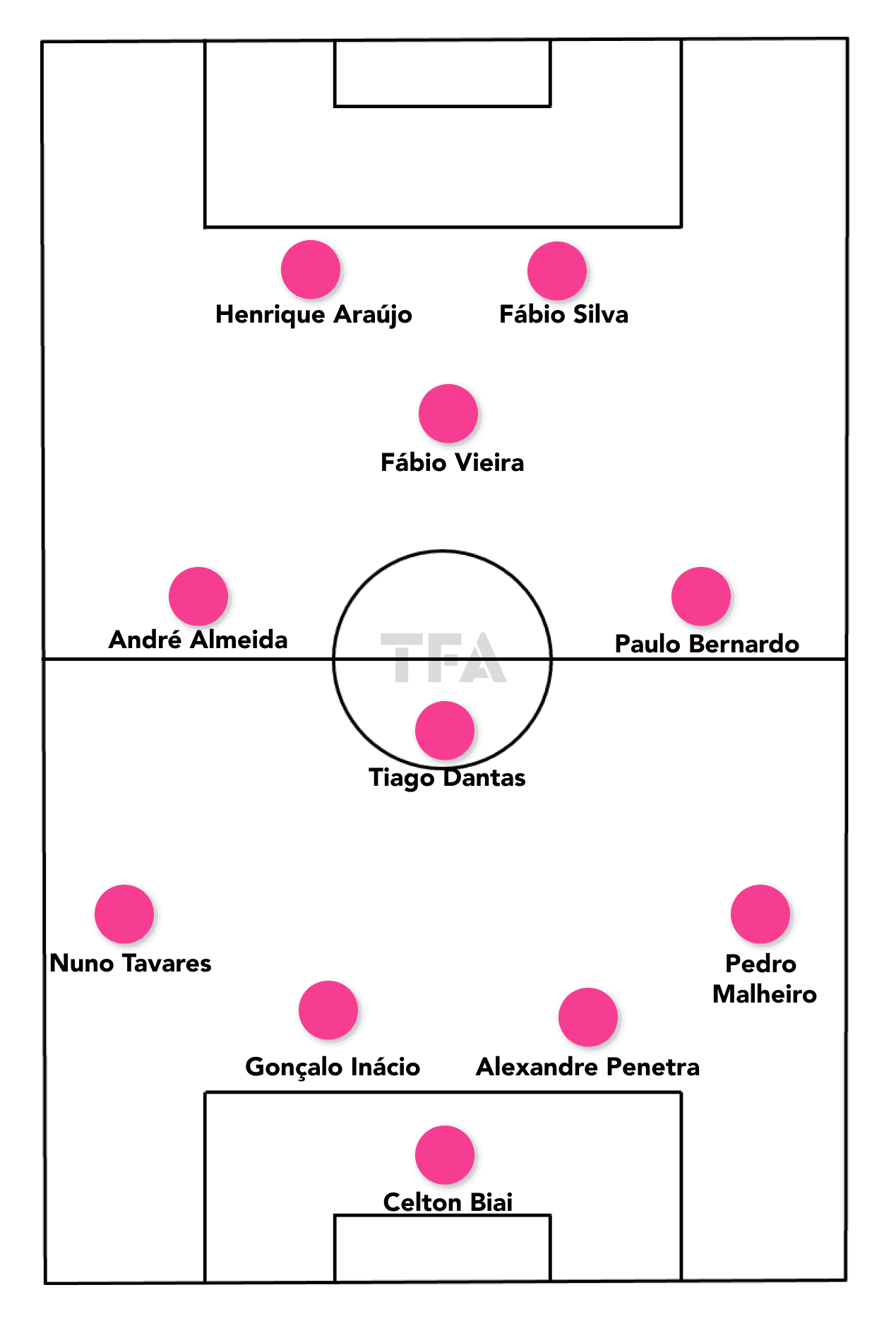
It is expected that the team will play in their favoured 4-3-1-2 formation, with the coach occasionally switching to a scheme with a lone striker. He will be choosing between Celton Biai and Samuel Soares for the goalkeeping spot. It is most likely that he will rely on Biai as he was the main figure throughout the qualifying campaign.
Nuno Tavares will start at left-back, with Leonardo Lelo, who has contributed equally well, being the coach’s second option. Pedro Malheiro is expected to secure the starting spot on the right, instead of the other contender Rodrigo Conceição.
Jorge has a few options for the central defence, but will most probably rely on Gonçalo Inácio and Alexandre Penetra as regular starters.
Tiago Dantas will be deployed as the defensive midfielder, who is expected to enhance the connection between the lines, while André Almeida and Paulo Bernardo will support him centrally.
The coach usually relies on an attacking midfielder which in this case will be Fábio Vieira, who is the team’s captain and one of the top goalscorers. His other options for that position are Afonso Sousa and David Costa.
Up front, Portugal are expected to play with Fábio Silva and Henrique Araújo in the absence of Conceição and Ramos.
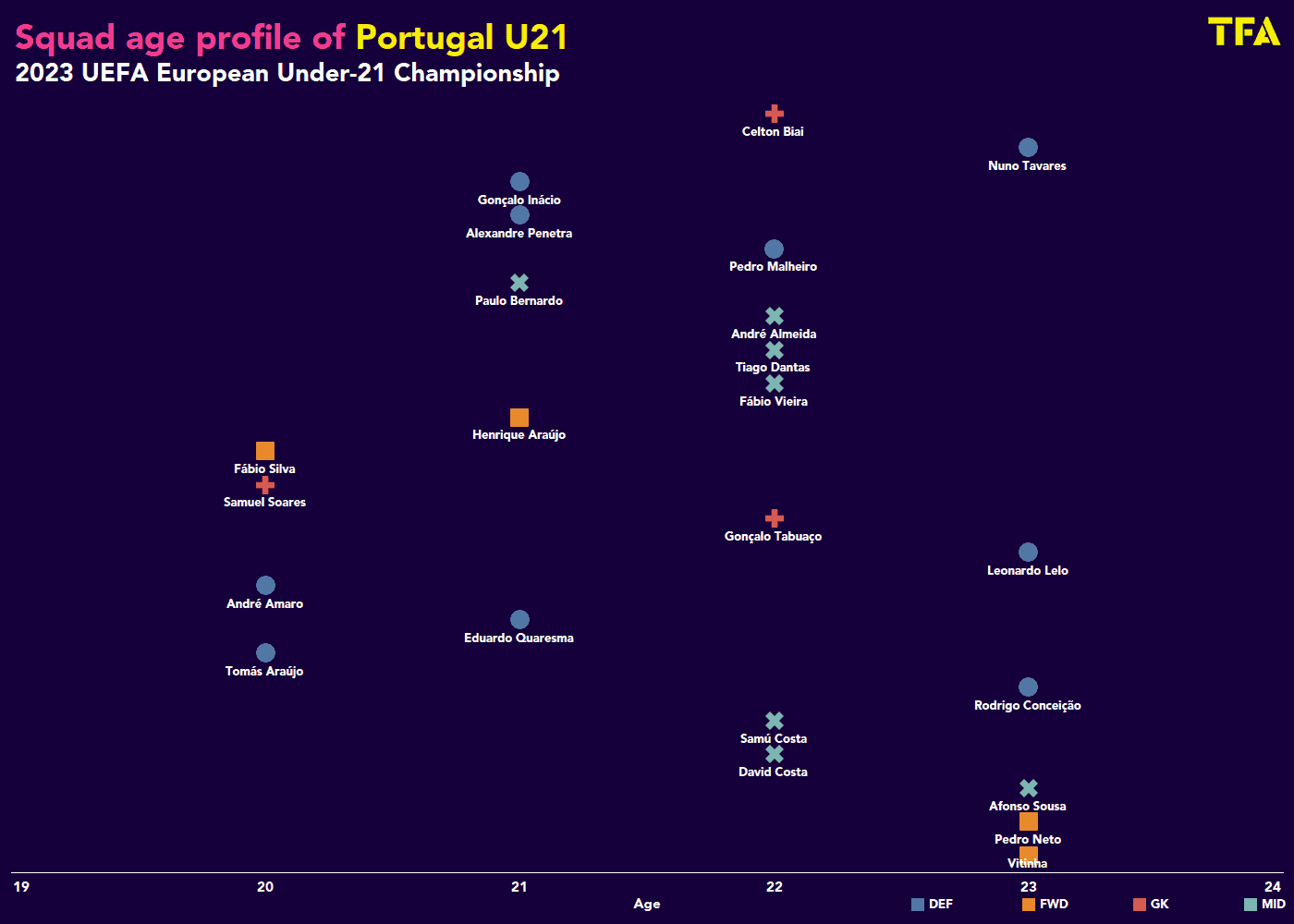
As shown in the age profile of the team, the age range is between 20 and 23, with most of the players already being over 21 years old, having gained experience on a club level.
Attacking Phase
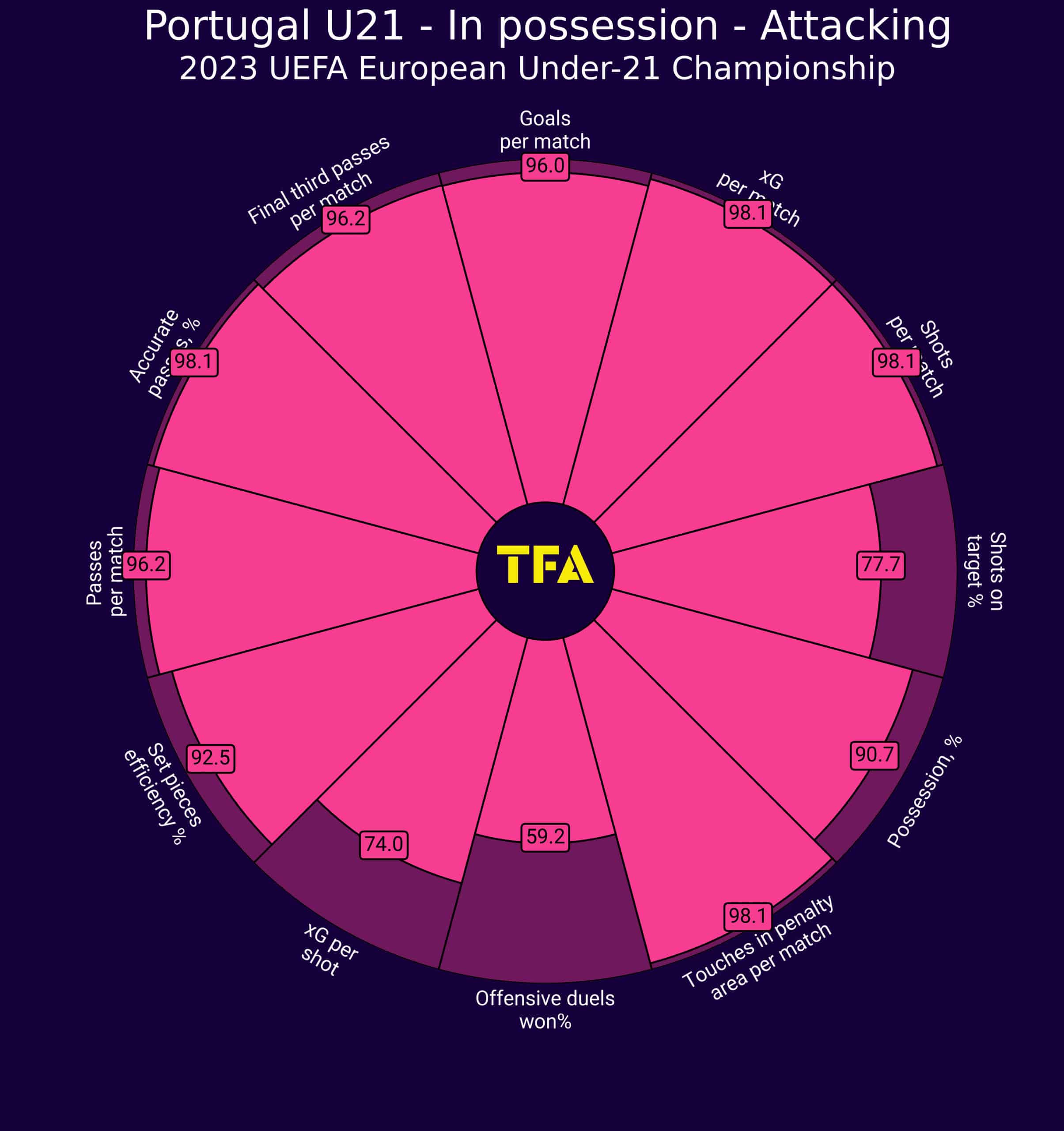
As mentioned, Portugal are an attack-minded team that focus on their actions in possession and try to threaten the goal as frequently as possible. The chart above underlines their dominance in attack.
The team aim to control the game in the opposition half, staying positioned high as a unit and trying to retain possession. Their success in possession is based on their frequent and successful passing, which dispositions the opposing players and opens spaces. Their high pass accuracy allows them to have more of the ball and quickly advance it to the final third where they most frequently aim for crossing attempts (28.33 per 90).
The U21 players have averaged 25.33 shots per 90 in the qualifiers, which were often produced after an accurate cross and thanks to the team’s fluid attacking movement.
As the chart shows, many of their efforts have resulted in goals, making them one of the most efficient teams. Their success is more of a result of the high frequency of their attempts rather than their accuracy in front of the goal. Many of their shots go to waste due to inaccuracy, that’s why they rely on creating a high number of opportunities to increase their chances to score.
The biggest strength of this squad is their ability to do positional interchanges. You will see the full-backs cut inside, the central midfielders go out wide and cross and the forwards drop back. Their constant movement and change of positions make it difficult for the opposition to react. The team are equally successful from close distance and from outside the box which underlines their versatility up front.
Jorge’s side are efficient from set-pieces as well. Their crossing abilities help them in converting corner chances into goals.
Defensive Phase
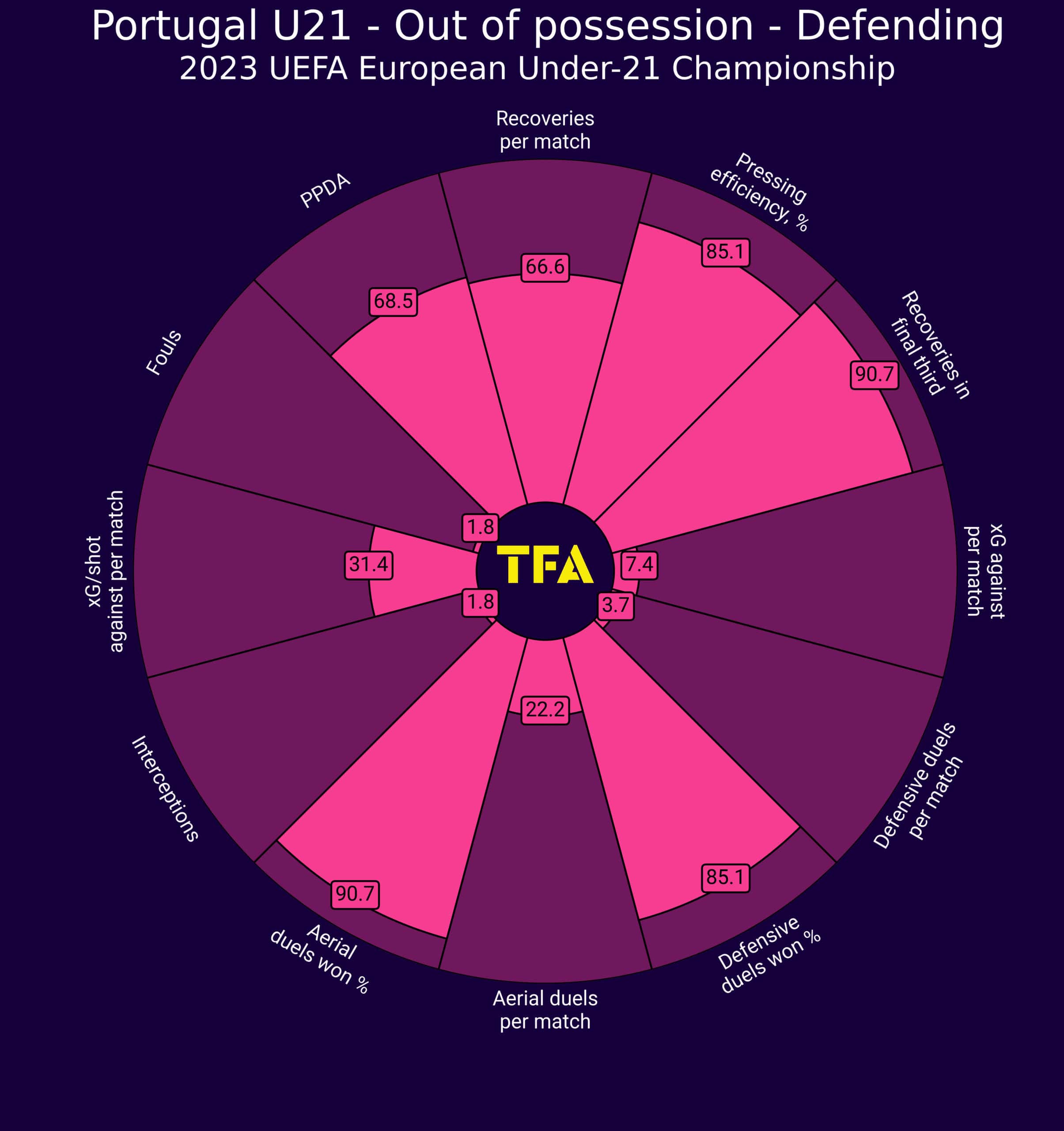
Their focus on the attacking actions doesn’t mean they are neglecting their defensive responsibilities. The team are quite methodical defensively, especially when it comes to their pressing efforts.
As their defending chart suggests the team constantly aim to recover the ball, especially in the final third so they keep it away from their goal while being able to create chances in attack. Their pressing efforts are considerably intense as well, averaging a PPDA of 6.14 in their last three qualifiers. While many of the other teams have a higher press intensity, the chart shows Jorge’s side are among the most efficient in their efforts. Their low number of fouls per 90 adds to their success.
Portugal’s number of defensive challenges isn’t high due to their dominance, however, they are successful in both defensive duels and aerial duels. That helps them in recovering possession and increasing their time on the ball.
Their defensive line is usually very high, right behind the central line, with the aim of pushing the opposition back and making offensive transitions easier.
Transitions
The team tend to retain possession at the back and build up from there. They would usually do pass combinations between all four players in the defensive line and the defensive midfielder. That gives them the opportunity to progress with the attack in the best possible way as opens both the flanks and the central channels.
Their high pass frequency allows them to make smart combinations and disposition their markers, freeing their way forward. The players prefer advancing the ball methodically and very rarely rely on counterattacking actions despite having pace and technical abilities.
They actively exploit the wide areas through the full-backs who constantly move to advanced positions and contribute to the attacking actions. The other player that has a key role both in their build-up play and their defensive transitions is Dantas. He covers the central areas and orchestrates play but also frequently recovers the ball and blocks the opposing attacks when out of possession.
Their counter-pressing efforts are key for their defensive performance as their pressing movement during transitions often stops their opponents from playing the ball out of the defence.
Attackers
As mentioned, Jorge is in a delicate situation considering the absence of some of the attackers that helped the team qualify. Silva has thrived at club level despite the multiple transfers in 2022/2023 and is expected to be a key figure in Portugal’s current set-up.
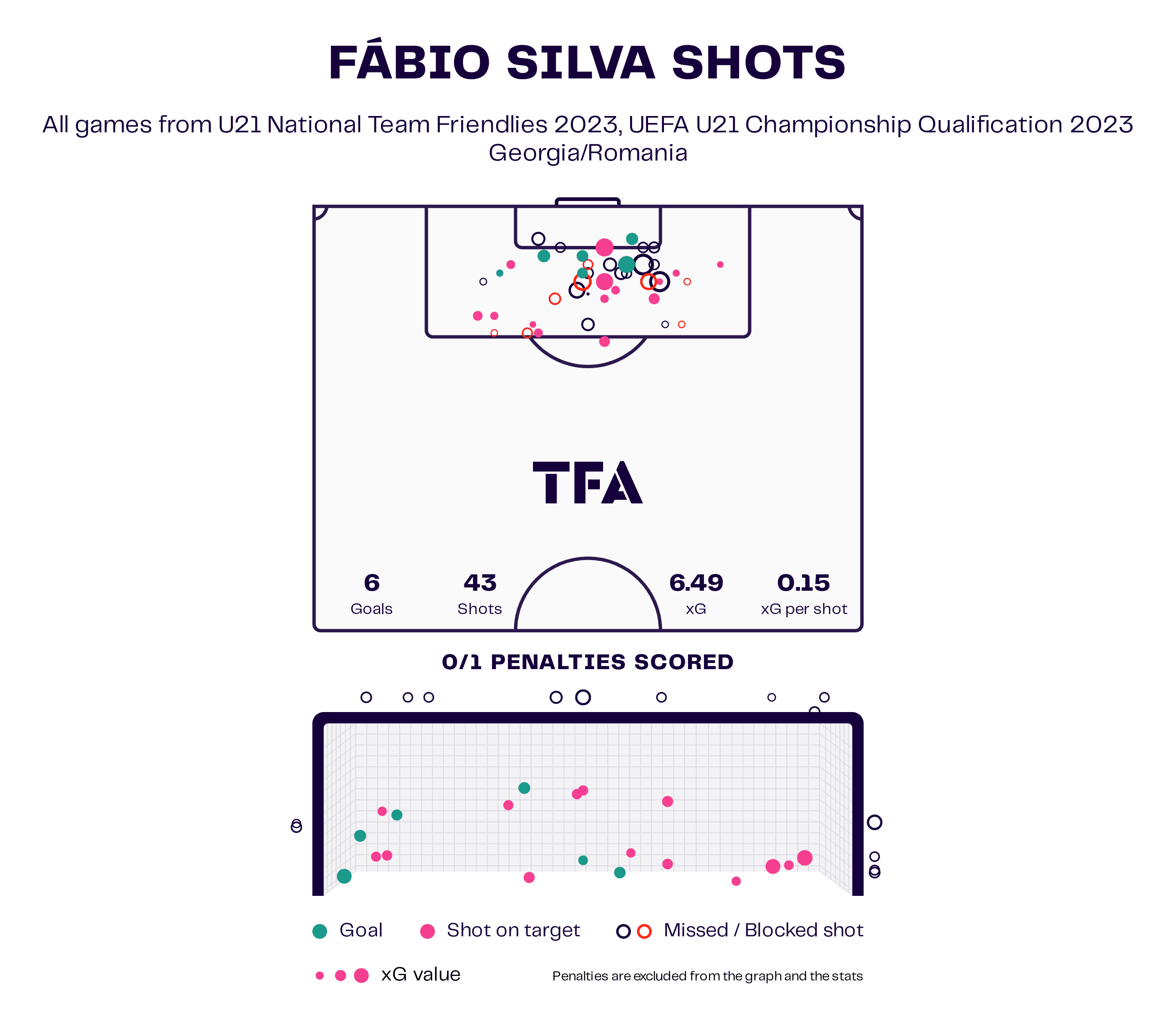
He will be key for Portugal in attack as through his positioning in the box he provides passing options and is a direct threat to the goal. His shot map illustrates the areas from which he usually shoots. As shown, he is the most efficient from a close distance, which is beneficial for the team due to their tendency to cross the ball frequently.
Araújo, on the other hand, doesn’t have many playing minutes for both Benfica and Watford but is expected to be relied on as he performed well in the qualifiers and scored three goals.
Jorge has a few attacking options, although it is not yet clear what will be his final choice. Vitinha is most probably going to be included in the squad as he has experience as a centre-forward, second-striker and right-winger, giving the coach more versatility should he change the formation.
However, it will be difficult for Portugal to be as productive as in the qualification due to the lack of a distinguished striker like Ramos.
Midfielders
The coach usually picks attack-minded players that can occupy multiple areas and open channels. As mentioned, Dantas is responsible for distributing the ball all over the pitch, while the rest of the midfielders do link-up-play and provide support to the full-backs.
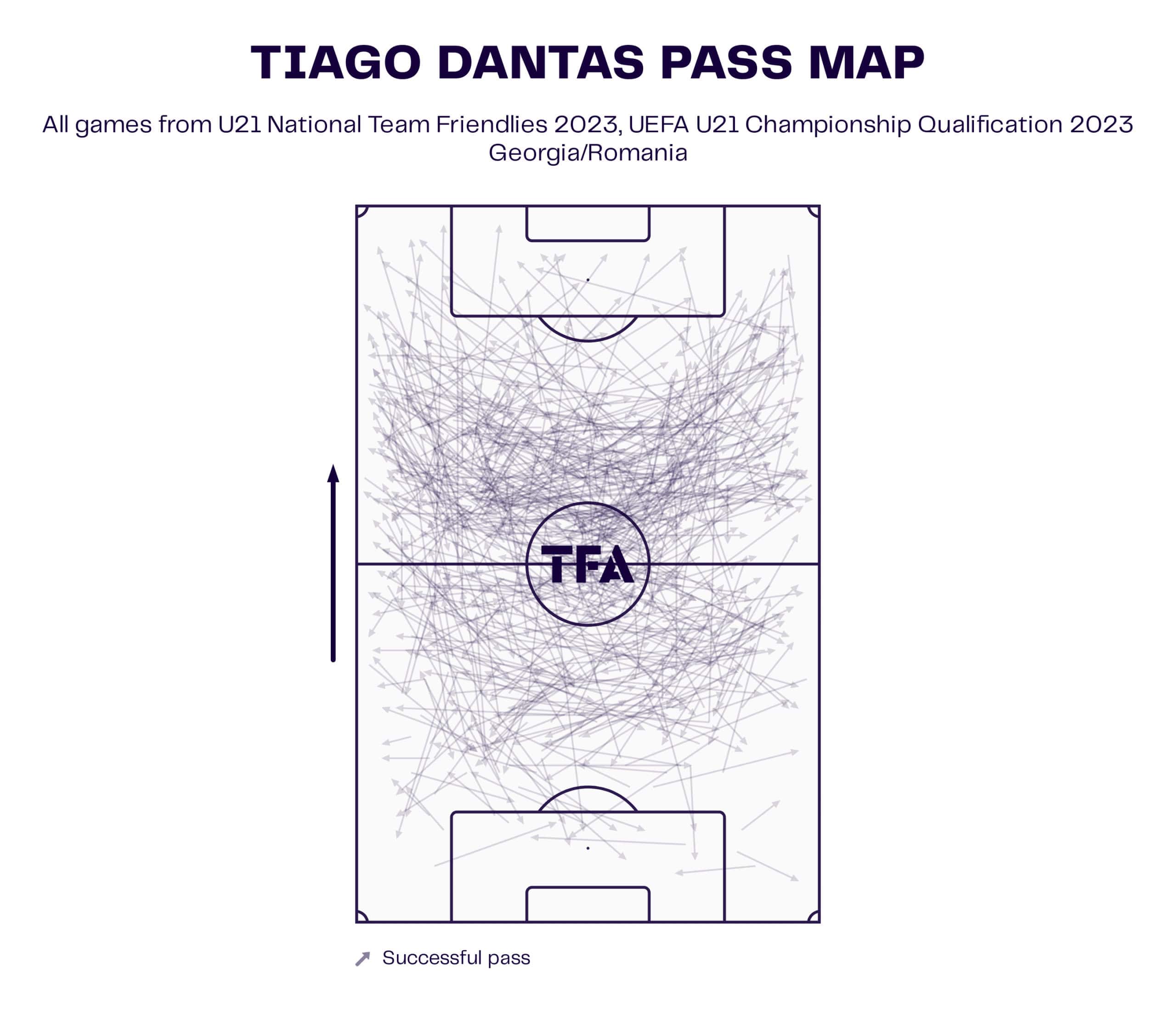
As shown in Dantas’ pass map from the qualifiers and the latest friendlies, he orchestrates play from his central position and often spreads out wide as well as combines with his teammates centrally.
Bernardo and Almeida are relied on due to their passing skills and ability to support their teammates with their movement. The attacking midfield starter, Vieira, is the leader of the team, not only through his captaincy but also through his goalscoring.
Costa and Sousa are more attack-oriented and usually move into quality positions, providing a direct threat to the goal.
Defenders
Jorge has more options defensively. Both Tavares and Lelo are very proactive on the left, as well as Malheiro on the right.

As shown in the map, Tavares is very valuable on the left not only due to his ability to progress the ball and cross but also because of his ability to cut inside. The left-back constantly tries to penetrate the defence and provide a threat to the goal, increasing the team’s efficiency in attack.
Inácio and Penetra will most probably form the central pair. Both of them are regular starters for their teams in Liga Portugal and have gained invaluable experience this season. Penetra most frequently plays as a right back at a club level, which fits Jorge’s strategy well. He can cover a lot of space and move into a more advanced position or successfully cover depth for the right-back should the opposition attack the flank.
Key Player

Vieira’s roles at Arsenal and Portugal differ but the chart above correctly underlines his strengths. For the national team, he plays as an attacking midfielder who supports ball progression through his positioning and movement with the ball and is responsible for carrying the ball to the box.
He frequently exploits the penalty area and provides a threat to the goal. He is one of the team’s top goalscorers and fits their style of play well as he constantly looks to find gaps forward and create opportunities. He tends to shoot from a distance which provides more explosiveness up front and often catches their opponents off-guard.
His technical abilities allow him to hold on to the ball and use dribbling to bypass the opposing players. Despite his physique, he guards the ball well which leads to successful penetration to the final third.
Vieira has developed into Potugal’s main set-piece taker and is responsible for their corners and penalties. He is likely to be relied on with the captaincy as well as the team have already achieved a few wins under his guidance.
Tournament Prediction
Portugal are one of the favourites in the tournament. However, the task will be difficult with the likes of the other contenders Germany, France, England and the Netherlands. Jorge’s side need to be consistent in their approach and rely on the players’ strong connection, especially against teams that match their style of play.
It is expected that they will proceed to the knockout stage, where, if they manage to compensate for the absence of their best performers, they can realistically qualify for the semi-finals.

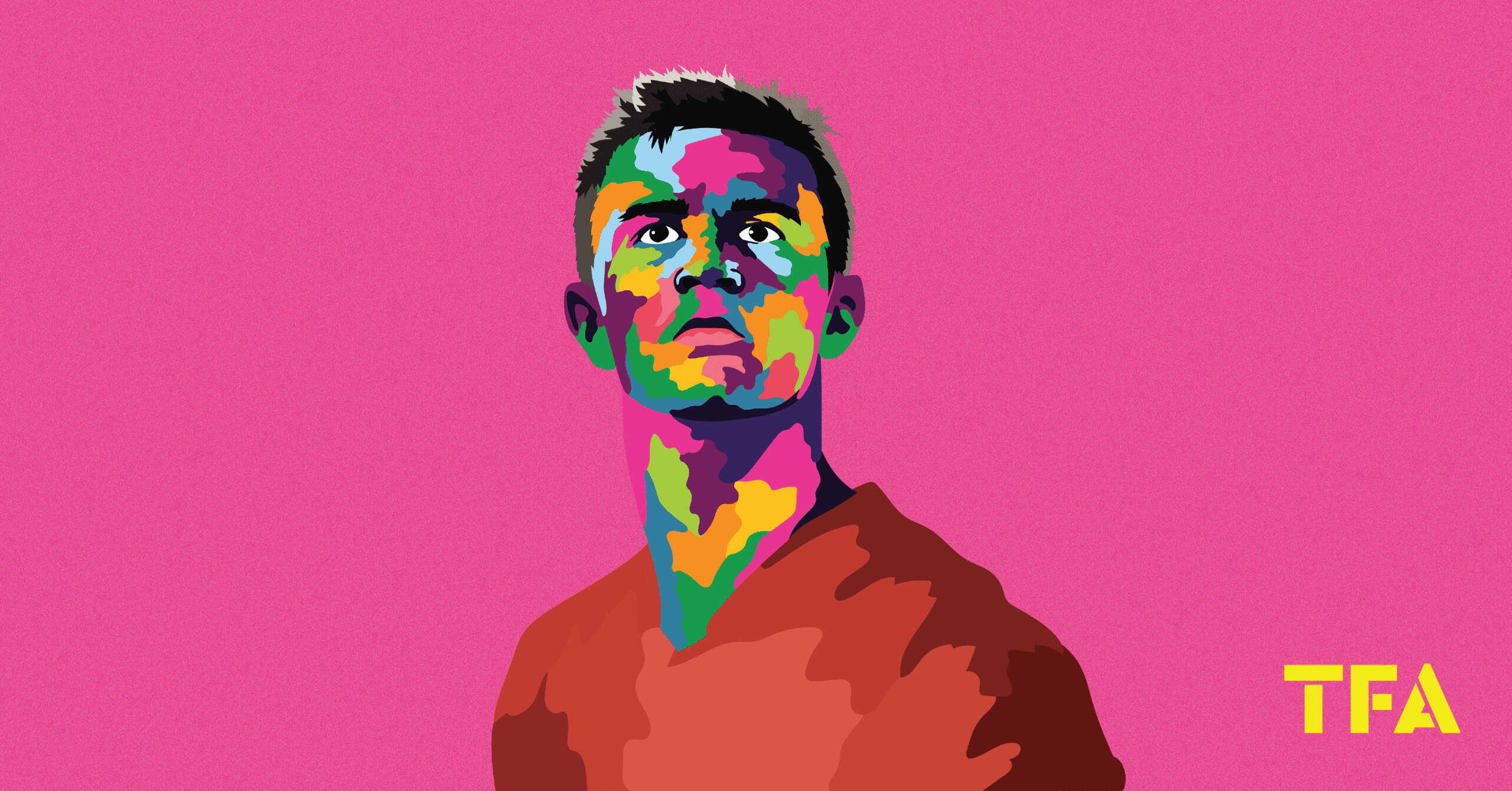




Comments